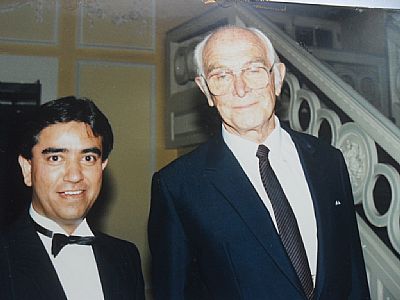 Satis Shroff's CREATIVE WRITING | sitemap | log in Satis Shroff's CREATIVE WRITING | sitemap | log in
|
 |
||
| This is a free Spanglefish 1 website. | ||
Grzimek's Work Must Not Die(Satis Shroff)
Satis Shroff with Prof. Grzimek at the La Redoute(Bonn). Petra Kelly (Green) was also there, wearing a pastel green pullover. Fischer, Bonn’s well-known society photograph, confided to me that he took pics without a flash using high DIN or ASA films. But today it’s digital and movie mode in one.
Berhard Grzimek born on April 24, 1909 was a veterinary, zoo-director who made films and was an excellent public relations personality. He was also an ecologist-cum-politician and the women just loved him. He did a lot to save endangered wildlife in different part of the world. When you think of Grzimek you can’t help thinking about his famous film ‘Serengeti Must Not Die.’ It was a film about north Tanzania’s environmental problems, especially wildlife, which he made in the year 1959 and which received an oscar. His son Michael directed the film with Berhard, and shortly thereafter Michael died. To save wildlife and to prevent the mishandling of animals, he never backed away from verbal confrontations and attacked mink-wearing actresses and profit-seeking African dictators who made money at the cost of wildlife in their countries. He was very active and gathered donations, and urged German politicians to engage themselves in wildlife conservation. The people in Frankfurt were shown a lot of attractions at the Frankfurter Zoo, which he’d re-made after the destruction during the World War II. The family had to suffer a lot because Bernhard Grzimek was constantly underway with his long-expeditions in different countries. It reminds me of the Swiss geologist Toni Hagen who was also absent for long periods as a geologist, and later as a development helper in Nepal. His wife and family were left alone in Lenzerheide. Grzimek’s desire was to save living animals in the world that were being decimated by poachers armed with modern guns from wars in Africa and who stood under contract with dictators and other parts of the world. The list of endangered animals is growing longer despite Grzimek’s pleas and endeavours, as can be seen in the impressive WWF Artenschutz ‘The Endangered Animals of the Earth.’ Over 5487 mammals are endangered. Borneo, which is the home of the Orang Utans, has been cutting down 13,000 square kilometres of primeal forest every years, with the result that that habitat of these animals is rapidly disappearing. The Siberian Armur leopard has been decimated to just 40 animals. As to the blue whales, there are only 5000 left. Dramatic,eh?
Further reading: Claudia Sewig: The man Who Loved the Animals, Lubbe verlag, 480 pages, 24,95 euros. |  |
|
 | ||
